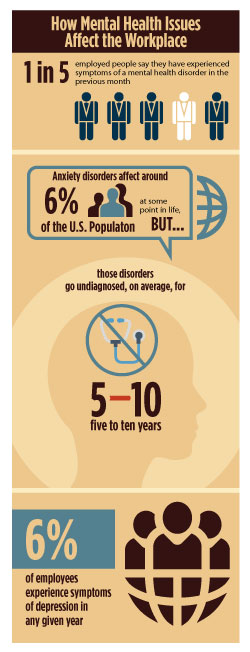For many employees, the holidays are the most wonderful time of the year; for others, they intensify pre-existing stress and anxiety. This article explains how to spot the "holiday blues" and more serious mental health problems in employees -- and address these issues constructively.
How Mental Health Issues Affect the Workplace
Mental health issues are very real, and very common. In fact, they are the second-leading cause of absenteeism in the American workforce. According to data provided by Harvard Medical School, nearly one in five employed people say they have experienced symptoms of a mental health disorder in the previous month. Anxiety disorders affect around six percent of the U.S. population at some point in life, but those disorders go undiagnosed, on average, for five to 10 years; and six percent of employees experience symptoms of depression in any given year.
When left untreated, mental health issues lead to increased absenteeism, decreased productivity, safety concerns, higher employee turnover, lowered employee morale, and increased risk of other illness.
None of which are good for business!
Is it the "Holiday Blues" -- or Something More Serious?
To properly address mental health issues in the workplace, managers and supervisors in your organization must learn to recognize the signs of anxiety, depression, and substance abuse in employees. Every situation is unique, but the most common signs include:
Don't Diagnose: Address Performance Issues
Recognizing the signs of mental health disorders is important, but unless you're a trained mental health professional, you're probably not equipped to diagnose these issues. So rather than acting on assumptions, deal only with the performance issues that stem from these disorders.
Use these tips:
Legal Considerations
Mental Health and The ADA
Mental health conditions are covered under the Americans with Disabilities Act. As such, large companies will be required to provide employees with reasonable accommodations including flexible hours during treatment and recovery, time off for doctor's appointments, leave for hospitalization and frequent performance feedback.
Your human resources department should be well versed on ADA accommodations, and managers should receive training on the ADA, as well.
Mental Health Parity
The Mental Health Parity and Addiction Equity Act requires group health insurance issuers to provide nonrestrictive access to mental health treatments. This means that insurers cannot treat mental health, behavioral health, or substance abuse disorders any differently than other medical benefits. Copays and deductibles should apply to mental health treatment in all group plans that cover 50 or more employees.
Supporting Mental Health in Your Workplace
Even if your organization is too small to be governed by the ADA or the Mental Health Parity Act, there are things you can do to help address mental health in your organization. Review your company-sponsored insurance plan to be sure that mental health treatment is covered by copays or deductibles. Early treatment is important to help employees recover quickly.
Wellness plans, designed to help employees prevent illness through proactive measures, can also be used to address mental health. These programs offer incentives for annual checkups, preventive care, and even gym and fitness programs. A physically fit employee is more likely to be a mentally fit employee.
Remember to post mental health information in the company breakroom along with other safety and workplace posters. Include community mental health resources, suicide prevention hotlines, and post the signs of mental illness so that employees can learn what changes and signs to watch for in themselves and their co-workers. Some useful resources for employers include:
The best way to handle mental health issues in the workplace is to remove the stigma associated with these disorders. Include discussions of mental health in employee onboarding and training programs, and have the HR department conduct occasional mental health seminars for managers. Often, simply by talking about these issues openly, employees will recognize signs in themselves and will feel more comfortable addressing their issues.
Final Thoughts
When employers take the time to understand how mental health issues affect the workplace, it's easy to see how addressing the problem can alleviate long-term issues. When employees feel comfortable talking about their problems, asking for help, and when they can seek help through the company-sponsored health insurance program, it will lead to a more productive and healthy workforce.Good Cheer or the Holiday Blues?


